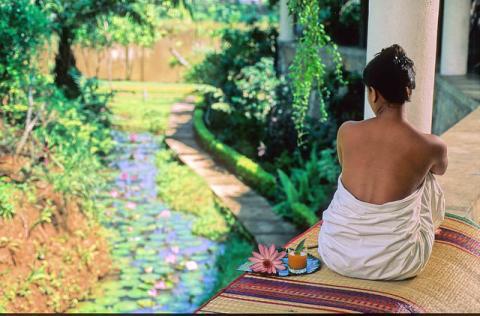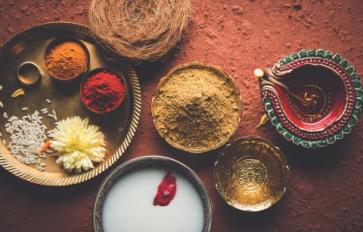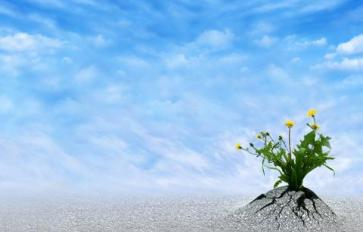
In the west, adhering to “western medicine” does not necessarily equate to health. Yearly trips to the doctor’s office and allopathic treatments rarely bring a person closer to wellness, nor do they contain the necessarily elements to inspire an individual to take powerful control over their personal well-being and bodily health.
In the east, especially in India, Ayurveda is the system of health translated as “the science of life.” Those who adhere to Ayurvedic principles find not only improved physical health and well-being, but mental clarity, emotional stability and spiritual attunement.
Ayurveda, as a largely physical system for bodily strength and constitutional balance, is part of what could be called “the trifecta of wellness” in the east - including the bodies of wisdom known as Yoga – for spiritual embodiment, and Tantra – for mental evolution.
Some westerners may perceive Ayurveda as a daunting system, too complex to incorporate easily into daily life. Yet there are certain aspects to this ancient science that are simple to understand and easy to implement into one’s regular schedule which can help improve health and extend life.
Here are 3 simple, easy to incorporate Ayurveda Techniques for improved health.
1. Daily Self Oil Massage
In Ayurvedic medicine, the act of massaging oneself daily with oil is essential to well-being. Depending on one’s natural constitution, different oils can be used to keep skin toned and body temperature balanced such as sesame oil to bring warmth or almond oil to cool. Other oils that can be used are coconut, avocado, olive oil, apricot or jojoba.
Either prior to, or after a shower (depending on school of thought or personal preference), self-oil-massage is a great way to retain moisture and correct imbalances in the skin including eczema, psoriasis and acne. Oil massage also moves the lymph and keeps one psychologically connected to oneself, bringing a sense of grounding, self-nurturance and healing to an otherwise emotionally dry or mentally instable person. On a simpler note, oil massage just feels good and where a person might have no other physical contact, or regular ability to receive massage, self-massage is a beautiful way to offer self-care and reinforce the important quality of self-love in one’s life. Whether you choose to self-massage prior to, or following a daily shower depends on which benefits are most advantage and appealing to you. Prior to a shower, many practitioners couple oil massage in the same category as dry brushing to enhance circulation. After a shower, adding an oil massage to your daily regime helps to lock in heat and moisture while complementing the nurturing qualities of the shower.
To find out which oil is most beneficial for you, a simple self-test can be taken to find out your personal body type by googling Ayurvedic Constitution Quiz. Or, just use your intuition and pick the oil that is most attractive or interesting to you today.
2. Post-meal Digestive Relax Method
After every meal, in order to increase digestive potency and allow the body to focus on breaking down the food and achieving maximum benefits from the food, it is recommended to engage in a post-meal digestive relax posture. Because of the stomach’s position, in Ayurvedic philosophy, it is suggested to lie down on the left side for 10-15 minutes following every meal. In this way, the blood flow is concentrated on the stomach and digestive faculties so as to improve their functions and speed food break-down and assimilation.
In the west, people are accustomed to eating on the go or hurrying from meal time on to the next engagement. By taking even just a few minutes post-meal to lie down and acknowledge the digestive process, the body is aided in improved health and the mind is allowed this short break to reflect on what is occurring within. By engaging in such an easy Ayurvedic technique, one is able to extend life by slowing down time, acknowledging the bodily processes and eliminating the disturbances often caused by eating too fast and the indigestion that often occurs by the rushing so many engage in.
3. Cold Water Rinse for Longevity
Many, if not most, people love their hot showers. We often think of the shower as the place to warm up, get clean and perhaps gain some life insights. Few like taking cold showers, and if they do, it seems more so for the “wake-up” or “cool-off” benefits than for any other reason. But in Ayurveda, the cold rinse is purely a health-move meant to stimulate the circulatory system, push heat out from the core, and ultimately extend life.
In order to practice the cold water rinse, one would take a “regular shower” as usual, followed by a minute or two of cold water at the end (as long as one can handle). The cold water should hit the crown of the head as the first rule and as a bonus area – an anal rinse/massage. This second part assists in tightening the anal sphincter muscles, therefore preventing hemorrhoids, and stimulating the life-force energy known to lay coiled at the base of the spine – referred to as the kundalini.
By enduring the cold water rinse, in both stages, one is left feeling invigorated and refreshed on every level. Cold water on the crown is especially useful in bringing mental clarity and removing fatigue and is also very good for the eyes, ears and pineal gland functions.
By utilizing the self-oil massage, post meal digestive relax and the cold water rinse for longevity - three very simple Ayurvedic techniques - one can realize improved health and increased body attunement in a relatively short period of time. Try these techniques out for yourself and see how amazing you feel today. Stay tuned for more Ayurvedic tips on how to live a longer, richer, healthier life of clarity and peace through practicing the renowned ancient “Science of Life.”
Cover Image Source: Flickr








